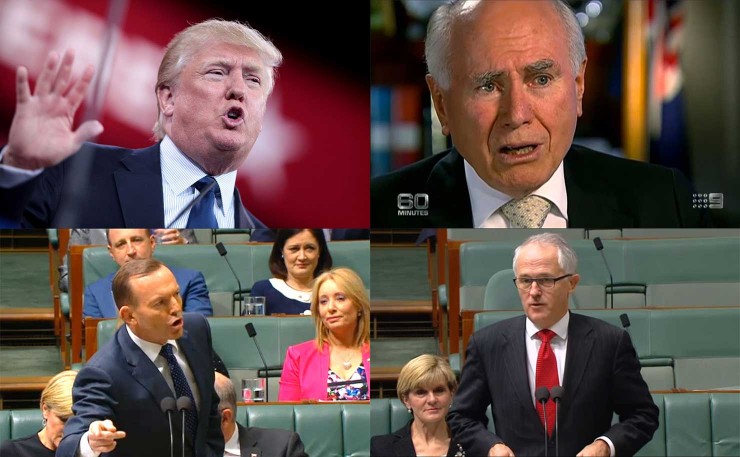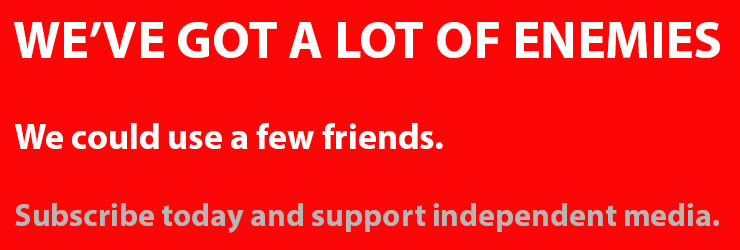That question sounds like the start of a bad joke. And if you look too closely, you’ll realise your society might just be the punchline. Sean Hosking picks at the bones of neo-liberalism and fear-based politics.
If you thought the Donald Trump presidential campaign couldn’t get any more bizarre, the documentary maker Michael Moore recently announced he had reliable information from multiple sources that Trump, initially at least, never intended nor desired to become president of the United States, and that his candidature was an attempt to boost his public profile as a means of leveraging a higher fee for his reality TV show.
Though this may seem far-fetched, on a certain level it makes sense. Just as various hoaxes have revealed the absurdities of the literary establishment and the actor Joaquin Phoenix exposed the celebrity cult of personality by impersonating a movie star in mid breakdown, so the ludicrous Trump persona – one part deranged fabulist, two parts wrestling show impresario, and three parts eastern bloc dictator – in many ways only makes sense as satire.
Maybe what we have been watching during this presidential campaign is American culture finally eating itself. A tragicomic apocalyptic reality TV farce in which Trump sensationally games the most powerful office on earth, casually slandering minorities, ludicrously promising to build walls between nations, comically proclaiming that Obama founded Isis, pushing the bounds of good taste, logic, credulity, and hair styling to the maximum while all the while exposing the decadence of the American political establishment and the gullibility of the voting public. A reality TV blockbuster to end all blockbusters, and, potentially, civilisation.
As great a TV spectacle as this would be, it is obviously not plausible in relation to what we know about Trump himself, a man so vainglorious that he has a bathroom lined in gold and has publicly talked about the virtues of his penis. Whether it is the biggest plane, the most glamorous wife, the glitziest hotel, or the most powerful office in the world, Trump is a guy who aspires to the best that life has to offer, or at the very least the biggest.

But whether you view him as a serious figure or a reality TV star on the make, the fact that an abject buffoon of such epic proportions has made it to within a hair’s breadth of the Presidency says a lot about the parlous state not just of American society and politics, but of the dominant ideological frameworks that hold sway across most of the western world.
On one level, Trump is just the most extreme cultural artefact of a society that is increasingly breaking away from its enlightenment moorings and descending into a maelstrom of techno junk culture, gauche sentimentality, consumer nihilism, market hucksterism and political chicanery which has left many people unable to make even the most elementary distinctions between reality and bullshit, their own interests and the interests of others.
With his orange salon complexion and pseudo heroic pout he is like one of those poorly made plastic action man figures that little boys use as a prop for their fledgling macho/power fantasies. Pull the string on his back and he delivers a hypnotic stream of snake oil salesman flimflam and reassuring tough man trash talk totally undisturbed by any intrusions from the real world.
In an age when the fetishisation of material wealth has obliterated many of the behavioural constraints that once went with social privilege, Trump presents as a supreme parody of the excesses and delusions of the super-rich. A property developer who does not read books, has few interests in life outside of making money and whose knowledge of self appears to be little more than an amalgam of the size of his bank balance and the gratuitous flattery of the lickspittles and sycophants with whom he surrounds himself.
That such an individual can successfully sell himself as a saviour to people who literally have the arses hanging out of their pants indicates both the degree of frustration, anger and despair felt by many Americans, and the depth of the failure of mainstream political institutions.
As many have now observed, what Trump and politicians like him offer to such people is not so much answers and solutions, as a space to vent their frustration. The grinding competitive individualism of late capitalism has deprived many people of any meaningful relationship with their local communities and broader societies, pumping them full of the escapist narcissistic fantasies of consumerism, celebrity culture and pop psychology while at the same time taking away their financial autonomy, job security, skills, initiative and self-respect.
Add the bitterness that comes with rampant social inequality and is it any wonder that many people are attracted to the crudest political products on the shelf? The ones that tell them that all their problems are caused by minorities, foreigners, welfare recipients and elites, and that they can regain control of their lives and be ‘great’ again if these illegitimates could just be put back in their box.

Though Trump may have gone rogue in rejecting various shibboleths of Republican free market economic ideology, in essence his crude divisive populism is just an extension of the mainstream right’s slow drift to what not long ago constituted the political margins. Whether it be the Coalition government in Australia or the Republicans in the US, the basic formula in essence is simple, circular and well worn: exploitation of the insecurity, prejudices and grievances of the socially disaffected as a means of politically counteracting the negative effects of policies that have overwhelmingly favoured a privileged minority and which created the disaffection in the first place.
In Australia reversion to this brand of politics began two decades ago following the election of the Howard Government. From Howard’s historic violation of the post white-Australia policy prohibition on race-based politics and his long campaign against the social ‘elites’, to Tampa, the ‘children overboard’ affair, the concerted denigration of people on welfare, the Orwellian rhetoric associated with border protection and the hell holes on Nauru, to Tony Abbott’s desperate attempts to leverage political capital from the stigmatisation of Muslims and terrorism fear mongering, the politics of divisive nationalism, minority scapegoating and xenophobia have increasingly become a standard component of Coalition efforts to remain electorally viable.
The utility of this kind of politics has been clear ever since Paul Keating was unceremoniously dumped from office in 1996 by a public reeling from 13 years of economic reform. For all its mooted success the neoliberal period has been characterised by regular debt fuelled boom and bust cycles, jobless growth, recessions, financial crisis and catastrophic levels of inequality.
It has failed on most economic indicators to match the post-war Keynesian social democracy that it replaced, with the average annual growth rate of world GDP declining from 4.9 per cent between 1950 and 1973, to 3.0 per cent between 1973 and 1992, and to 2.7 per cent between 1990 and 2001. By 2014 the richest 85 people in the world controlled wealth equivalent to half the world’s population, with 65 per cent of total household net worth in Australia controlled by 20 per cent of the population.
Unemployment rates in Australia are on average 5 percentage points higher in the post 1983 period, up from an average unemployment rate of 2 per cent in the post war period. In the face of rampant wealth and income inequality, those dependent on their labour for their livelihood have endured a marked deterioration in their working conditions, job security and economic well-being.
Tax cuts for the rich, privatisation, deregulation, de-unionisation and the trashing of public services have all massively impacted on overall quality of life in ways that can’t be made up by the ubiquitous accessibility of flat screen TVs and iPhones.
It is a fact often forgotten in the rush to ideologically mythologise the ‘achievements’ of the Howard government that its adoption of components of the Hanson agenda in the first half of its period in office was a direct result of its floundering political fortunes as the negative effects of neoliberal economic restructuring began impacting on the Australian community.
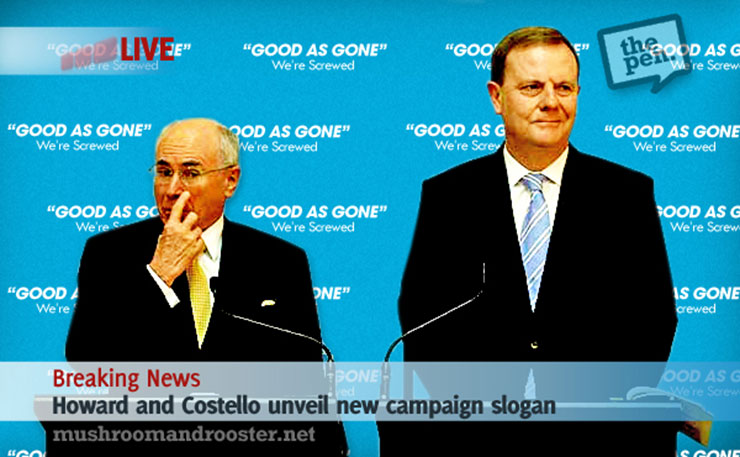
Probably the greatest political achievement of Howard was his capacity to effectively walk both sides of the street, pursuing economic policies that impacted heavily on Australian egalitarian traditions, family life and personal security, while at the same time mouthing socially conservative white picket fence homilies to a ‘relaxed and comfortable’ Australian idyllic.
In the first half of his prime ministership in particular, Howard was a dog looking for a whistle, ever hunting for social issues that he could successfully exploit through the deft application of his trusty populist wedge and invocation of what it meant to be ‘un-Australian’.
It was only after the world economy boomed in the period after September 11, 2001 and the resources boom flooded government coffers with windfall gains, that Howard was able to turn around his political fortunes by engaging in the most comprehensive and profligate program of pork barrelling in Australian history.
Fast forward to the disastrous Abbott government, which erroneously believed that Howard’s electoral success was due in large part to his dedication to economic ‘reform’ and that the neoliberal fetish for budget surplus’ was shared by the wider community, regardless of the economic environment.
Following the resounding rejection of Abbott’s 2014 text book neo-liberal slash and burn budget, and the related resurgence in the articulation of egalitarian values within the community, the Coalition had no other option but to double down on the politics of fear and division.
Abbott’s problem was that rather than presenting as a ‘strong leader’ or ‘man of steel’ as John Howard had (ludicrously) managed to do, and deprived of the favourable economic climate that Howard had enjoyed, he instead appeared to the public as something akin to what he actually was: a rather pathetic jumped up political delinquent hopelessly out of his depth, down on his political luck and desperately on the lookout for anybody or anything that might be fashioned as a ‘sovereign’, ‘national’, ‘civil’, ‘existential’, or ‘civilisational’ threat.
Shirt fronting Putin, unilaterally sending troops to the Ukraine, posing on fighter jets or with uniformed defence personnel, Abbott was on a perpetual quest to atone for his weakness at the policy level by beating somebody, anybody, up.
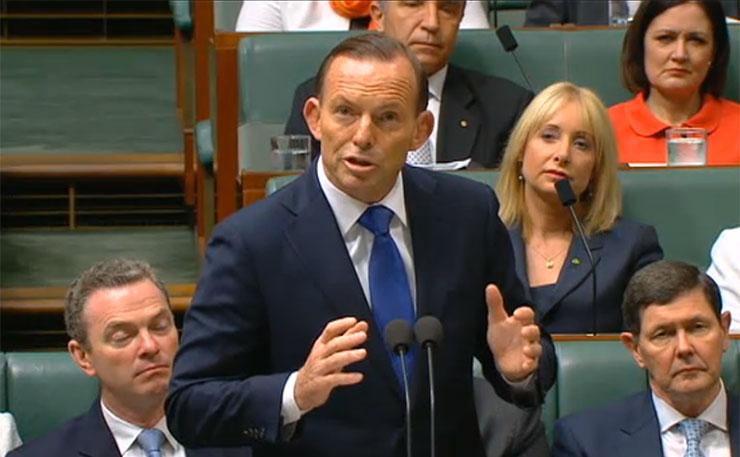
While the Labor party at least nominally has few institutional impediments to freeing itself from the neoliberal straight jacket, the Coalition currently has no such capacity and is in crisis: a fact that is not appreciated by the many political pundits who appear to think that Malcolm Turnbull’s failure as prime minister can be explained in terms of his ‘performance’.
Whatever the extent of Turnbull’s leadership qualities – and there is reason to believe that they are wildly overestimated – Turnbull leads a party that is effectively paralysed; captive to business interests that are electorally toxic, tightly bound to an ideology that is in terminal decline, and perpetually held to ransom by an unhinged hard right obsessed with various petty vendettas and boutique libertarian issues.
This alone explains why Turnbull was forced to hold his breath and go to an election with a $50 billion tax cut to the big end of town, a rancid ideological policy left over from the Reagan era long since spurned by all but the most constitutionally resilient right wing zealots.
For a guy who came to office promising innovation and an intelligent and open policy discussion, the humiliation was complete. There were simply no other policy options available in a party that, since Howard, had progressively divested itself of its capacity to freely and actively engage in the Australian public policy debate.
Indeed most of the criticism of Turnbull’s leadership from within the Coalition has not been in relation to policy – nobody in the Coalition appears to have a clue what to do in this regard beyond closely reading the op-ed pages of the Australian – but rather in relation to his incapacity to run hard on the politics of fear and division.
What is apparently required is more photo ops with security personnel pouring over maps, more national security briefings in front of a requisite number of flags, and more talk of Muslims terror plots.
The problem is that Turnbull is simply not able to engage in fear mongering and diversional beat ups with the same degree of authenticity as a Howard or a Trump. His heart is clearly not in it.
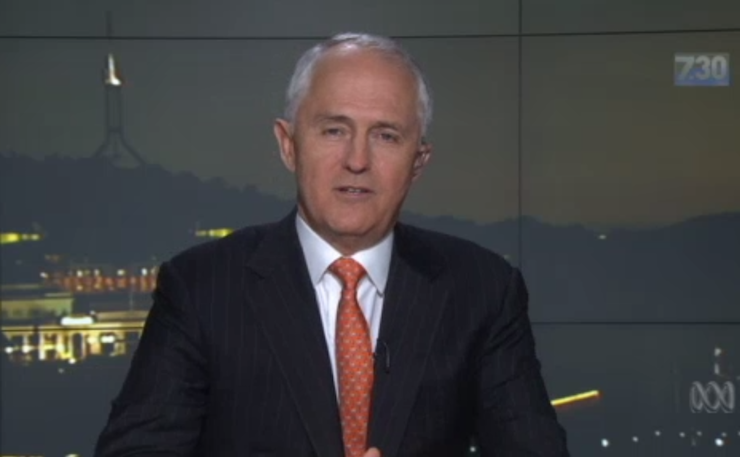
In the absence of this and any viable alternative economic narrative, the Coalition is currently bereft of political identity, living off lingering community perceptions of their superiority as economic managers while running up a deficit almost triple that which they inherited, unable to make the most elementary decisions without tying themselves up in knots. The resurrection of Abbott or reversion to another flag draped right wing hard liner sometime in the near future is all but inevitable.
Ultimately the escalating descent into the politics of division reflects something more than the surface interplay of political dynamics. It reflects the terminal decline of the neo-liberal frameworks on which the global economic and political establishment is built.
The corporate free-for-all that has plundered the world for the last 30 years is reaching its limits, and the ideological ‘truths’ that have underpinned it are coming apart in the face of social, economic and environmental realities that are impervious to ideological dogma and the endless pseudo rationalisations of the dismal science.
Supply side economics has failed in the face of intractable stagnant growth, the Laffer curve has snagged on the roots of social inequality, the efficient market hypothesis has become untenable in the face of irrational market failure, competitive markets have been overrun by corporate monopolies, prosperity narratives flounder in the face of unprecedented household debt and social immobility, and the growth fetish has morphed into a death cult in the face of extreme environmental degradation.
If there is any value in the rise of figures like Donald Trump it is that they serve to expose both the extent of this dislocation and the disaffection that it has generated within the wider community.
The question is, will the political establishment see the writing on the wall and respond effectively and realistically to the emerging socio-political and environmental crisis or will it follow the likes of Howard, Abbott and Trump into the political abyss?
Donate To New Matilda
New Matilda is a small, independent media outlet. We survive through reader contributions, and never losing a lawsuit. If you got something from this article, giving something back helps us to continue speaking truth to power. Every little bit counts.

